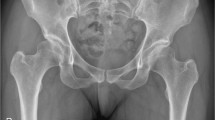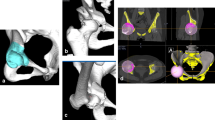Abstract
Purpose
The aim of study is to evaluate the accuracy of a navigation system during curved peri-acetabular osteotomy (CPO).
Methods
Forty-seven patients (53 hips) with hip dysplasia were enrolled and underwent CPO with or without navigation during surgery. Clinical and radiographical evaluations were performed and compared between the navigation group and non-navigation group, post-operatively.
Results
The clinical outcomes were not significantly different between the navigation and non-navigation groups. Furthermore, post-operative reorientation of the acetabular fragment was similar between the navigation and non-navigation groups. However, the discrepancy between the pre-operative planning line and post-operative osteotomy line was significantly improved in the navigation group compared with that in the non-navigation group (p < 0.05). Further, the complication rate was significantly improved in the navigation group (p < 0.001).
Conclusion
The accuracy of the osteotomy’s position was significantly improved by using the navigation. Therefore, the use of navigation during peri-acetabular osteotomy can avoid complications.





Similar content being viewed by others
References
Nakamura S, Ninomiya S, Nakamura T (1989) Primary osteoarthritis of the hip joint in Japan. Clin Orthop Relat Res 241:191–196
Eppright RH (1975) Dial osteotomy of acetabulum in treatment of dysplasia of hip. J Bone Joint Surg Am 57:1172–1172
Ganz R, Klaue K, Vinh TS, Mast JW (1988) A new periacetabular osteotomy for the treatment of hip dysplasias. Technique and preliminary results. Clin Orthop Relat Res 232:26–36
Ninomiya S, Tagawa H (1984) Rotational acetabular osteotomy for the dysplastic hip. J Bone Joint Surg Am 66:430–436
Schramm M, Pitto RP, Rohm E, Hohmann D (1999) Long-term results of spherical acetabular osteotomy. J Bone Joint Surg Br 81:60–66
Naito M, Shiramizu K, Akiyoshi Y, Ezoe M, Nakamura Y (2005) Curved periacetabular osteotomy for treatment of dysplastic hip. Clin Orthop Relat Res 129–135
Millis MB, Murphy SB, Poss R (1996) Osteotomies about the hip for the prevention and treatment of osteoarthrosis. Instr Course Lect 45:209–226
Novais EN, Carry PM, Kestel LA, Ketterman B, Brusalis CM, Sankar WN (2017) Does surgeon experience impact the risk of complications after Bernese periacetabular osteotomy? Clin Orthop Relat Res 475:1110–1117. https://doi.org/10.1007/s11999-016-5010-1
Ito H, Tanino H, Sato T, Nishida Y, Matsuno T (2014) Early weight-bearing after periacetabular osteotomy leads to a high incidence of postoperative pelvic fractures. BMC Musculoskelet Disord 15:234. https://doi.org/10.1186/1471-2474-15-234
Zaltz I, Baca G, Kim YJ, Schoenecker P, Trousdale R, Sierra R, Sucato D, Sink E, Beaule P, Millis MB, Podeszwa D, Clohisy JC (2014) Complications associated with the periacetabular osteotomy: a prospective multicenter study. J Bone Joint Surg Am 96:1967–1974. https://doi.org/10.2106/JBJS.N.00113
Mast JW, Brunner RL, Zebrack J (2004) Recognizing acetabular version in the radiographic presentation of hip dysplasia. Clin Orthop Relat Res 418:48–53
Hipp JA, Sugano N, Millis MB, Murphy SB (1999) Planning acetabular redirection osteotomies based on joint contact pressures. Clin Orthop Relat Res 314:134–143
Liu L, Ecker TM, Schumann S, Siebenrock KA, Zheng G (2016) Evaluation of constant thickness cartilage models vs. patient specific cartilage models for an optimized computer-assisted planning of periacetabular osteotomy. PLoS One 11:e0146452. https://doi.org/10.1371/journal.pone.0146452
Pflugi S, Liu L, Ecker TM, Schumann S, Larissa Cullmann J, Siebenrock K, Zheng G (2016) A cost-effective surgical navigation solution for periacetabular osteotomy (PAO) surgery. Int J Comput Assist Radiol Surg 11:271–280. https://doi.org/10.1007/s11548-015-1267-1
Murphy RJ, Armiger RS, Lepisto J, Mears SC, Taylor RH, Armand M (2015) Development of a biomechanical guidance system for periacetabular osteotomy. Int J Comput Assist Radiol Surg 10:497–508. https://doi.org/10.1007/s11548-014-1116-7
Radermacher K, Portheine F, Anton M, Zimolong A, Kaspers G, Rau G, Staudte HW (1998) Computer assisted orthopaedic surgery with image based individual templates. Clin Orthop Relat Res 354:28–38
Otsuki B, Takemoto M, Kawanabe K, Awa Y, Akiyama H, Fujibayashi S, Nakamura T, Matsuda S (2013) Developing a novel custom cutting guide for curved peri-acetabular osteotomy. Int Orthop 37:1033–1038. https://doi.org/10.1007/s00264-013-1873-x
Tonnis D, Heinecke A (1999) Acetabular and femoral anteversion: relationship with osteoarthritis of the hip. J Bone Joint Surg Am 81:1747–1770
Takao M, Nishii T, Sakai T, Sugano N (2017) Comparison of rotational acetabular osteotomy performed with navigation by surgeons with different levels of experience of osteotomies. Int J Comput Assist Radiol Surg 12:841–853. https://doi.org/10.1007/s11548-016-1494-0
Hasegawa Y, Iwata H, Mizuno M, Genda E, Sato S, Miura T (1992) The natural course of osteoarthritis of the hip due to subluxation or acetabular dysplasia. Arch Orthop Trauma Surg 111:187–191
Cartiaux O, Banse X, Paul L, Francq BG, Aubin CE, Docquier PL (2013) Computer-assisted planning and navigation improves cutting accuracy during simulated bone tumor surgery of the pelvis. Comput Aided Surg 18:19–26. https://doi.org/10.3109/10929088.2012.744096
Hsieh PH, Chang YH, Shih CH (2006) Image-guided periacetabular osteotomy: computer-assisted navigation compared with the conventional technique: a randomized study of 36 patients followed for 2 years. Acta Orthop 77:591–597. https://doi.org/10.1080/17453670610012656
Inaba Y, Kobayashi N, Ike H, Kubota S, Saito T (2016) Computer-assisted rotational acetabular osteotomy for patients with acetabular dysplasia. Clin Orthop Surg 8:99–105. https://doi.org/10.4055/cios.2016.8.1.99
Albers CE, Steppacher SD, Ganz R, Tannast M, Siebenrock KA (2013) Impingement adversely affects 10-year survivorship after periacetabular osteotomy for DDH. Clin Orthop Relat Res 471:1602–1614. https://doi.org/10.1007/s11999-013-2799-8
Author information
Authors and Affiliations
Contributions
S. Haya designed the study. S. Haya, S. Hashi, KT, TM, KI, and NS collected the data. S. Haya and TM interpreted the data. KN performed the statistical analysis. S. Haya drafted the article. RK conducted the critical review and made the final approval.
Corresponding author
Ethics declarations
The study protocol was approved by our institutional ethics committee on September 8, 2011 (No. 1219), and informed consent for participation in the study was obtained from all participants.
Conflict of interest
The authors declare that they have no conflict of interest.
Rights and permissions
About this article
Cite this article
Hayashi, S., Hashimoto, S., Matsumoto, T. et al. Computer-assisted surgery prevents complications during peri-acetabular osteotomy. International Orthopaedics (SICOT) 42, 2555–2561 (2018). https://doi.org/10.1007/s00264-018-3906-y
Received:
Accepted:
Published:
Issue Date:
DOI: https://doi.org/10.1007/s00264-018-3906-y




